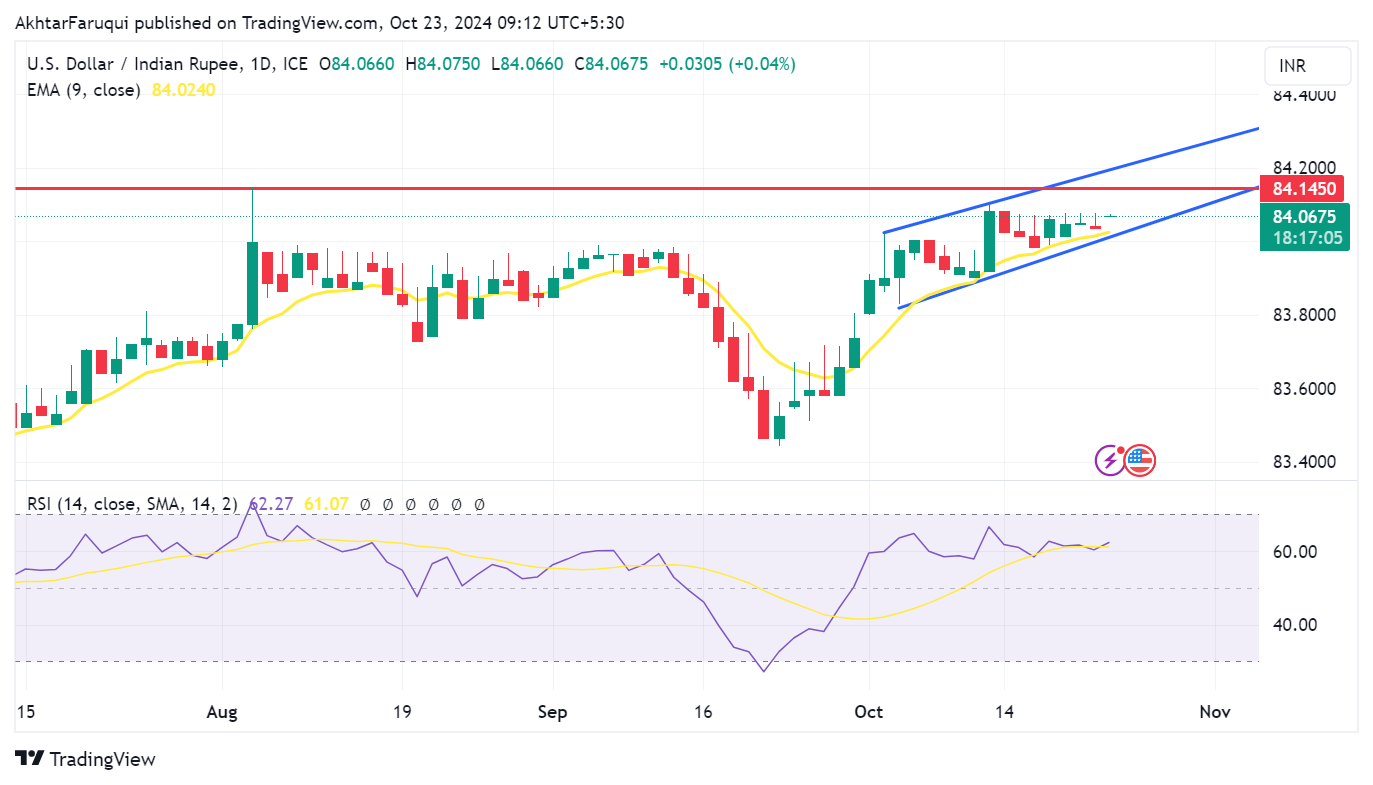USD/INR meets upward ceiling due to potential RBI interventions, eyes on 16th BRICS Summit
- The Indian Rupee receives downward pressure from sustained outflows in Indian equities.
- Indian PM Modi is set to meet Chinese President Xi Jinping on the second day of the BRICS Summit.
- The US Dollar appreciates as Treasury yields continue to rise amid increased risk aversion.
The Indian Rupee (INR) remains relatively stable against the US Dollar (USD) on Wednesday. However, traders noted that potential interventions by the Reserve Bank of India (RBI) limited the upward movement of the USD/INR pair.
The Rupee receives downward pressure from outflows, as foreign institutional investors have sold around $10 billion in Indian stocks so far this October, exceeding the previous record monthly outflow of $8.35 billion set in March 2020, according to a Reuters report.
Indian Prime Minister Narendra Modi and Russian President Vladimir Putin on Tuesday held a meeting on the sidelines of the 16th BRICS Summit in Kazan. During their discussion, Modi expressed his desire for peace in Ukraine and conveyed that New Delhi is prepared to assist in reaching a truce to resolve Europe's deadliest conflict. Modi is also scheduled to meet Chinese President Xi Jinping on Wednesday.
Daily Digest Market Movers: Indian Rupee faces challenges due to outflows from domestic equities
- The US Dollar appreciates as Treasury yields rise amid rising odds of nominal rate cuts by the Federal Reserve (Fed). Meanwhile, yields on 2-year and 10-year US Treasury bonds are at 4.04% and 4.21%, respectively.
- According to the CME FedWatch Tool, there is a 91% probability of a 25-basis-point rate cut, with no expectation of a larger 50-basis-point cut.
- In a speech at the New York Fed Central Banking Seminar, RBI Deputy Governor Michael Patra stated, "We believe that the best defense against global risks is to strengthen the macroeconomic fundamentals and build adequate buffers, supported by prudent macroeconomic policies." He highlighted that India’s central bank has been strategically increasing its foreign exchange reserves, which are now equivalent to or nearly equal to 12 months' worth of imports.
- In a post on the social media platform X, Federal Reserve Bank of San Francisco President Mary Daly stated that the economy is clearly in a better position, with inflation having fallen significantly and the labor market returning to a more sustainable path.
- Federal Reserve Bank of Minneapolis President Neel Kashkari highlighted on Monday that the Fed is closely monitoring the US labor market for signs of rapid destabilization. Kashkari cautioned investors to anticipate a gradual pace of rate cuts over the coming quarters, suggesting that any monetary easing will likely be moderate rather than aggressive.
- The Reserve Bank of India stated in its October bulletin that aggregate demand in India is expected to rebound from the temporary slowdown observed in the second quarter, driven by a surge in festive demand and an increase in consumer confidence.
Technical Analysis: USD/INR maintains position above 84.00, nine-day EMA
The USD/INR pair continues to trade above 84.00 on Wednesday. A review of the daily chart shows that the pair is consolidating within an ascending channel pattern, indicating a bullish trend. The 14-day Relative Strength Index (RSI) is also above the 50 mark, reinforcing the current bullish momentum.
In terms of resistance, the pair may encounter a challenge at its all-time high of 84.14, achieved on August 5, followed by the upper boundary of the ascending channel near 84.20.
On the support side, immediate backing is found at the nine-day Exponential Moving Average (EMA) around the 84.02 level, which coincides with the lower boundary of the ascending channel close to the psychological level of 84.00.
USD/INR: Daily Chart

US Dollar PRICE Today
The table below shows the percentage change of US Dollar (USD) against listed major currencies today. US Dollar was the strongest against the Japanese Yen.
| USD | EUR | GBP | JPY | CAD | AUD | NZD | CHF | |
|---|---|---|---|---|---|---|---|---|
| USD | 0.00% | -0.00% | 0.44% | 0.01% | 0.03% | 0.00% | 0.09% | |
| EUR | -0.00% | 0.01% | 0.46% | 0.04% | 0.06% | 0.02% | 0.12% | |
| GBP | 0.00% | -0.01% | 0.43% | 0.00% | 0.05% | 0.02% | 0.15% | |
| JPY | -0.44% | -0.46% | -0.43% | -0.43% | -0.53% | -0.57% | -0.39% | |
| CAD | -0.01% | -0.04% | -0.01% | 0.43% | 0.01% | 0.00% | 0.14% | |
| AUD | -0.03% | -0.06% | -0.05% | 0.53% | -0.01% | -0.01% | 0.12% | |
| NZD | -0.01% | -0.02% | -0.02% | 0.57% | -0.01% | 0.00% | 0.13% | |
| CHF | -0.09% | -0.12% | -0.15% | 0.39% | -0.14% | -0.12% | -0.13% |
The heat map shows percentage changes of major currencies against each other. The base currency is picked from the left column, while the quote currency is picked from the top row. For example, if you pick the US Dollar from the left column and move along the horizontal line to the Japanese Yen, the percentage change displayed in the box will represent USD (base)/JPY (quote).
Indian Rupee FAQs
The Indian Rupee (INR) is one of the most sensitive currencies to external factors. The price of Crude Oil (the country is highly dependent on imported Oil), the value of the US Dollar – most trade is conducted in USD – and the level of foreign investment, are all influential. Direct intervention by the Reserve Bank of India (RBI) in FX markets to keep the exchange rate stable, as well as the level of interest rates set by the RBI, are further major influencing factors on the Rupee.
The Reserve Bank of India (RBI) actively intervenes in forex markets to maintain a stable exchange rate, to help facilitate trade. In addition, the RBI tries to maintain the inflation rate at its 4% target by adjusting interest rates. Higher interest rates usually strengthen the Rupee. This is due to the role of the ‘carry trade’ in which investors borrow in countries with lower interest rates so as to place their money in countries’ offering relatively higher interest rates and profit from the difference.
Macroeconomic factors that influence the value of the Rupee include inflation, interest rates, the economic growth rate (GDP), the balance of trade, and inflows from foreign investment. A higher growth rate can lead to more overseas investment, pushing up demand for the Rupee. A less negative balance of trade will eventually lead to a stronger Rupee. Higher interest rates, especially real rates (interest rates less inflation) are also positive for the Rupee. A risk-on environment can lead to greater inflows of Foreign Direct and Indirect Investment (FDI and FII), which also benefit the Rupee.
Higher inflation, particularly, if it is comparatively higher than India’s peers, is generally negative for the currency as it reflects devaluation through oversupply. Inflation also increases the cost of exports, leading to more Rupees being sold to purchase foreign imports, which is Rupee-negative. At the same time, higher inflation usually leads to the Reserve Bank of India (RBI) raising interest rates and this can be positive for the Rupee, due to increased demand from international investors. The opposite effect is true of lower inflation.



